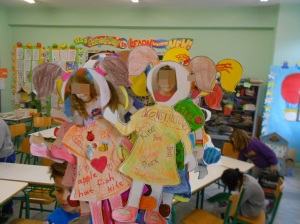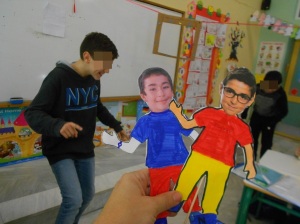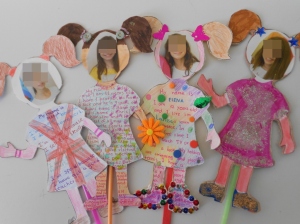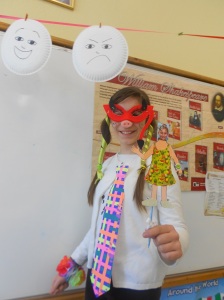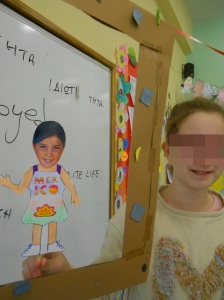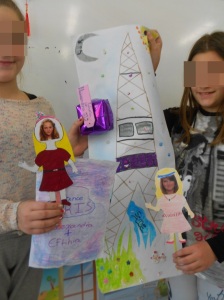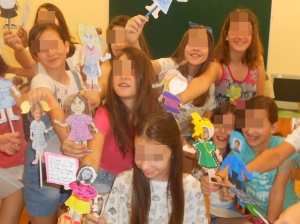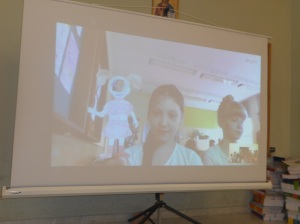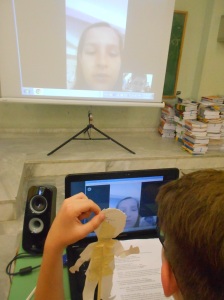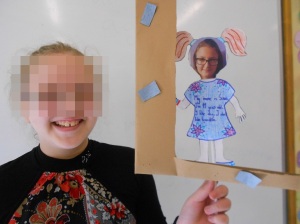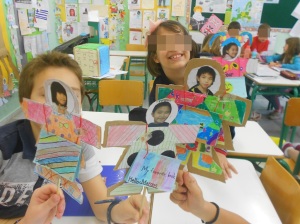I’ve always loved working with puppets, in our English class!
I strongly believe that, puppets play an important part in various aspects of a child’s development. The puppet provides the child with a kind of cover or disguise to hide behind: a timid child finds the courage to speak, to express his/her own emotions and to open his/her secrets to the puppet and through it to the audience. Thus the puppet helps the child to communicate much more spontaneously, avoiding stressed relations, especially with adults. The puppet is an authority selected by the child himself.
Through my experience in working with puppets, I believe in the magical power of the puppet in all kinds of communication with children, enlightening their talents and different forms of their creativity.
In our ETwinning project,this year, we decided to work with FLAT puppets, because, they were easy and cheap to travel in an envelope!
I also thought that, flat puppets would be important in improving visual sensitivity and orientation in space , especially for my younger students (a translation of a drawing into movement in relation to another animated form).
The use of our ETwinning puppets, actually resulted in a considerable contribution to a more humane and less stressed teaching environment and the socialization process, with our European peers. Moreover, puppets aroused my students’ imagination and creativity – the best dowry to a child for further development.
Promoting Peace and understanding among kids living in different countries and experiencing different cultural backgrounds ,was also one of my main targets, this year!
Actually, promoting peace was a large part of Dr. Montessori’s career – one of her most famous quotes is “Averting war is the work of politicians; establishing peace is the work of education.” She thought it was extremely important in her day; today it may be more important than ever…in both Europe and the World!
To me, Peace doesn’t mean the absence of conflict. That would be an idealized world in which none of us live. Rather, it’s learning how to deal with conflict in a way that doesn’t put the rights, wants, or needs of one person over the other. It’s learning conflict resolution skills that stress respect for the individual and the group, in our class and in today’s World.
Let me share some facts…:The European continent is culturally, economically and linguistically very varied and a survey carried out by the Council of Europe revealed an important diversity in the provision for the arts in schools throughout Europe.
In the same study, it was found that arts education provision in these countries, in many cases, also shows an inconsistency with national policy statements. They strongly emphasize the importance of a cultural dimension in education and encourage artistic and aesthetic development in young people, while in reality the status of and provision for arts education appear less prominent. Moreover, the emphasis on academic and technical education has a tendency to place the arts in the periphery of the curricula encouraging polarities between the arts and the sciences .
It was after I had read those facts when I thought..:Puppetry, is one such form of Art. I should use it to achieve my teaching goals in a fun and meaningful way.
Peace education can vary by age; older Primary School children will naturally be able to get into the history of peace, understanding others and conflict by studying different countries and cultures. In our project case, they could participate at a higher level by researching and writing about their lives, different cultures,sharing and comparing with their their European friends with the help of their Puppets.
During our Puppets project, we emphasized respect for the diversity of traditions and customs found around the world and in our European house!
Through the creation of several stories for the puppets theatre in class, students developed their artistic potential as a tool to explore the idea of tolerance and understanding of others.
After all, puppetry has been found to be an excellent tool for the teaching of multiculturalism to children.
First, I had to teach my young students, basic techniques used in creating live puppet theatre to be later able to use puppetry to incorporate multiculturalism into practice.
A few months later, as my little ones grew in understanding the feelings and needs of themselves and their European peers, their compassionate nature blossomed,too.
More, about this project:
The main goals of the project were :
• to promote group activities for tolerance and cultural understanding;
• to strengthen my students’ intercultural competences in order to be ready for responsible understanding of Europe’s identity and common values;
• to develop the European dimension through arts education (puppets) and creativity with the aim to promote multiculturalism and tolerance between students;
• To develop “Out-of-the-box” activities that would encourage mutual support, team building and group cohesion ;
• Encourage personalized learning approaches by acquiring new artistic and pedagogical skills with the aim of developing new ideas and creativity of the students involved in the project.
This old time classic pen pals project, gave a real purpose and meaning to learning a foreign language and helped the students experience education in a different country through European citizenship ,using a new tool: twinspace! The project lasted for about a school year and we had to complete many individual items . We had to create common projects about: ourselves, our school, our country , our town ,our favourite sports and hobbies, our customs and special traditions, our most favourite place in our countries , our daily routine and habits and also ,exchange OURSELVES as… PUPPETS ! We “traveled” to another country as our school and country ambassadors, and experienced life in another class, far away from home, for one school year! Puppet-students, wrote on their twinspace diaries about their adventures. Our projects and letters were both sent to our friends by snail mail and uploaded on twinspace, to share and compare in a different class.
This was a new and innovative partnership for my school; It was the first time that we had participated in such an innovative an ETwinning project.Both group work and independent research was used by pupils.
The innovation and creativity of the project is based on the following factors:
- All partner schools being inclusive of each other, working as one unit on each common project
- That the children felt able to be creative with their audience in the partner school in mind and dare to share and compare
- That the learning from the project was so significant that it will not be lost from children’s minds
- The Puppet-Ambassadors, created by and for the students ,served as a meaningful pathway towards understanding and learning more about our partners.
Before we started, the concept of Europe was not understood by most of the children, but now they are fully aware of the other European partner countries and their ways of life. Citizenship has become a practical rather than theoretical part of the curriculum.
The pupils were inspired and motivated. They had a great deal of fun working collaboratively .
Students had an opportunity to develop a sense of pride and respect toward other traditions. Our Puppet-Ambassadors, made Europe a more real concept, especially for those students who have never traveled abroad.
The organisation and commitment of the students has been very impressive.
The children showed a great interest in exploring another country and its way of life, as well as demonstrating increased motivation in learning a foreign language. They were always eager to participate, found information themselves, drew pictures, made posters, presented the project to other classes.
As far as my school is concerned, I made sure that almost all our project activities were connected to each of our English coursebook units. Luckily, our coursebooks , are based on both cross curricular and cross cultural topics quite relevant to our Etwinning project theme! Also, they are based on both creative project work and group collaboration which was highly helpful in our ETwinning project!
I teach English to ALL classes in my school! I therefore made sure that, ALL my 135 students, in all ages and language levels, took part in our ETwinning project, something that proved to be a real challenge!
All in all, a puppet can be their friend or their classmate, their ETwinning friend in our case… but at the same time is the child who moves the puppet. This is going to be the key thing while practicing another language and, if we use them correctly, they are one of the best resources that teachers can find and use in their foreign language classes.Not only to teach English but most importantly, LIFE AND SOCIAL SKILLS!
